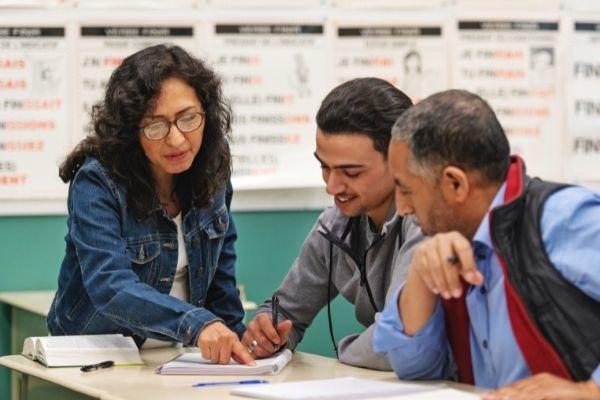Principles
As we work together with our members and community to meet our collective mission, the following outlined core principles will guide our work.
If you would like a digital copy of this strategic plan, please contact us.
About 80 per cent of all cardiovascular disease is preventable. As a research program, the Person to Population (P2) Cardiovascular initiative aims to facilitate research to improve cardiovascular prevention, detection, survival, and quality of life of impacted individuals and populations. The P2 program promotes understanding of the social and economic determinants of health and raises awareness of the cardiovascular risk factors in diverse populations.
The Person to Population (P2) Cardiovascular Research Collaborative group was initiated in 2016 by Dr. Hude Quan, AstraZeneca and Chiu Family Chair in Cardiovascular Health Promotion and Disease Prevention. From the onset, the group consisted of about a dozen researchers and has now expanded to over 60 members with research interests in health promotion and prevention, patient-centred care and engagement, health policy and economics and health outcomes.
The program focuses on optimizing the research collaboration of scientists at the University of Calgary promoting discussions on cardiovascular precision population health. It provides a platform for P2 members to convene and pursue their innovative research ideas through collaboration, leading to improved cardiovascular care and outcome.
To advance population cardiovascular health through member and community engagement in patient-oriented research, health outcomes research, and policy recommendations.
To lead and transform healthcare using precision cardiovascular health platforms.

As we work together with our members and community to meet our collective mission, the following outlined core principles will guide our work.
Collaboration is at the heart of what we do. We create a collaborative platform and seek to build opportunities for our members to come together to share their emerging research ideas while also receiving valuable feedback from their fellow members.
Transforming health care and improving the quality of life of individuals and populations requires an influx of novel and inventive ideas. We minimize the barriers and provide our members with balanced and objective knowledge and the necessary support to pursue their research ideas.
In our commitment to excellence, we seek to generate the highest quality evidence best available clinical and research evidence.
Our members join us from multiple disciplines making an impact through their expertise in various streams of cardiovascular research and care with a collective mission of improving population cardiovascular health. Building on the University of Calgary’s approach to unfold transdisciplinary scholarship, we focus on minimizing barriers and fostering collaboration between, across and beyond traditional disciplines.

Our initiative works together to make an impact in population cardiovascular care through these focus areas: research, education, and community outreach.
Research
The initiative facilitates and optimizes the research collaboration of Alberta scientists to promote high quality research on precision population cardiovascular health, contributing to optimal population CV health.
Education
The other area of focus for the Person to Population Cardiovascular initiative is to foster professional competence for the P2 members through the provision of resources and the establishment of opportunities for students, clinical trainees, and junior faculty.
Community Outreach
Health promotion and community outreach are critical aspects of P2, and most important to meet our mission of improving population cardiovascular health. We have combined the two aspects, packing them under one focus area. Our primary emphasis is to strengthen community actions through awareness and education of cardiovascular risk factors and outcomes.
The program’s three focus areas are embedded and represented in the goals and objectives stated below.
|
Goals |
Objectives |
Activities |
Key Performance Indicators |
|
To catalyze new collaborations between cardiovascular researchers. |
Create networking opportunities for cardiovascular researchers to assemble, share their potential research projects and secure collaborators for their projects. Utilize communication platforms to showcase our members’ work and potentially extend invitations to prospective members, who could join our P2 group. |
Organize 2-3 virtual/in-person retreats per year, allowing the members to network and get updates on ongoing projects undertaken by fellow members. Contact Libin’s Communication Coordinator to update P2 webpage every 6 months with new information on our members’ work and publish reminders about P2 retreats on monthly Libin newsletters.
|
# of attendees at P2 retreats (over 60% attendance rate). # of research collaborations among P2 members resulting from P2 retreats. # of social media posts on P2 members’ work on Libin social media platforms. # of retreats held throughout the year. |
|
To promote junior faculty members’ success within external grant opportunities.
|
Ensure junior faculty members are a part of Libin-supported research projects. Ensure junior faculty members have access to resources and the required support, setting them for success. Organize project competitions, encouraging early career researchers to participate and receive feedback on their projects, preparing them for external funding.
|
Plan one Test Your Concept project competition per year, encouraging junior faculty members to participate. Organize 1-2 mini grant/catalyst competitions per year for trainees and students to support their early-stage research projects. |
# of research projects presented by students/trainees. # of students and trainees involved in research projects leading to grant application submissions. # of mini-catalyst grants awarded to trainees and students.
|
|
To facilitate the production of novel evidence to inform cardiovascular care. |
Support the research projects undertaken by P2 members through assistance in grant application submissions. Arrange workshops and presentations on cross-cutting topics: the integration of sex and gender, social determinants of health, etc., to provide supplemental resources and further support P2 members’ research projects. Facilitate the research projects undertaken by members that focuses on enhancing access, acceptability and appropriateness of CV care, health promotion, and disease prevention for priority populations. |
Arrange workshops and presentations to promote the understanding and raise awareness of the impacts of income, socioeconomic status, education, physical activity, psychosocial stressors, and mental health on cardiovascular health. Provide research assistance to P2 members in grant application submissions. Equip members with balanced and objective knowledge from leading local, national, and international experts on topics such as the integration of sex and gender in research to help inform our members’ work. |
# of lectures and presentations organized for P2 members acting as a resource and refining their research projects. # of research projects that include the public and patients and their family members. # of research publications related to cardiovascular health by P2 members. # of research projects informed by the workshop and presentation learnings. # of research projects undertaken by P2 members that consider social determinants of health with a goal of improving the cardiovascular health of the priority populations. |
|
To empower the community members to have enhanced ownership of their health. |
Launch Ambassador program as a part of the community improvement plan to encourage community members to take an active role in improving their cardiovascular health. Organize community events throughout the year, engaging the public to adopt lifestyle changes and behaviours that could lead to improved individual and community health outcomes. Strategize plans to maximize public participation through social media campaigns motivating community members to incorporate healthy lifestyle and behaviours. |
Start the first recruitment cycle of Ambassador program that is designed to help ordinary Albertans become advocates for cardiovascular health in their communities. Arrange heart healthy cooking class once per year, providing members of the community with budget-friendly meal ideas through an immersive experience. Plan an in-person and group-style spin class, encouraging members to attain at least 30-min of physical activity per day. Organize yoga in the park event once per year (ideally Spring) to motivate community members to attain their physical activity amongst nature. Share pictures and posts of community events held on social media platforms to encourage more community members to join us in the journey of heart healthy lifestyle change. |
# of community members signing up as ambassadors. # of community members completing the Ambassador training program. # of community events held per year. # of successful community events with positive feedback (NPS score > 8) on surveys from community members. # of social media posts showcasing our community outreach events. |
|
To develop collaboration with researchers in cardiovascular health policy and health economics and identify pressing public health policy issues in cardiovascular health. |
Support the establishment of the Libin Health Policy program. Maintain an active social media/digital presence. Extend partnerships with other key stakeholders, clients, and cardiovascular researchers. Identify the pressing health policy issues in cardiovascular care through holding conversations with healthcare and policy leaders. Establish a regular and sustainable funding source for research and events undertaken by Libin Health Policy Initiative. |
Finalize the strategic document of Libin Health Policy program and come up with goals and objectives for the program. Update the Libin Health Policy program’s webpage with its mission, vision and values along with the goals set by the program in the next five years. Develop formal relationships with O’Brien Institute and the School of Public Policy. Conduct informal/formal interviews virtually or in-person with health care and policy leaders. Take on return-on-investment and research projects, such as, exploration of sugar beverage tax and its impact on CV health outcomes and study of PROMs as a measure to improve quality of life of patients. Take on health economics and policy consulting role/projects as a mean of revenue generation for LHPI. Apply for external and internal grant opportunities. Propose evidence-informed policy recommendations for healthcare decision-makers. |
Completion of the strategic direction of LHPI. Goal setting for LHPI for the next five years. Updated LHPI webpage with most updated information to generate awareness on the status and nature of program's work. # of return-on-investment projects undertaken. # of collaborations and partnerships with health policy and economics researchers in cardiovascular health. # of surveys conducted with stakeholders in leadership positions investigating future policy priorities # of consulting roles and projects undertaken. # of approved grant applications. # of research funding received. # of published policy recommendation papers/articles by LHPI team. # of research projects and return-on-investment projects published. |

